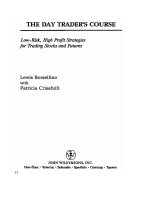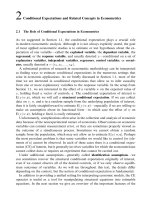Basic Chart Analysis: Trends, trading ranges, and support and resistance
Bạn đang xem bản rút gọn của tài liệu. Xem và tải ngay bản đầy đủ của tài liệu tại đây (153.68 KB, 4 trang )
Basic Chart Analysis: Trends, trading ranges, and support and
resistance
By Mark Etzkorn
If you've read The Technician's Basic Tool: The Price Chart, you're probably
familiar with the more popular chart types and how they display price information.
But knowing the difference between a bar chart and a candlestick chart is only
the beginning. Obviously, what's important is making sense of the price patterns
that develop over time.
Because price charts are a succinct record of price
action, learning how to analyze them is a logical first
step in the technical analysis journey. Further,
traditional chart patterns are a good first stop on this
trip, because they explain many of the basic principles
of price movement. We'll take a look at the simplest
kinds of chart patterns and what they reveal about
market behavior.
Chart pattern myth vs. reality
To the general public, the terms "technical analysis"
and "chart analysis" usually bring to mind images of
traders poring over price charts, deciphering hidden
To many, the term
"chart analysis"
brings to mind
images of traders
poring over price
charts, deciphering
hidden patterns in
much the same
way a fortune teller
would read tea
leaves
patterns in much the same way a fortune teller would read tea leaves.
Actually, despite the sometimes colorful names given to chart patterns, chart
analysis has a very common-sense goal: to locate price trends, congestion
areas, and points where trends are likely to reverse. "Patterns" can consist of a
single price bar or dozens, and can trigger trades that last a few hours or a few
months. To start, we'll focus on a few major price patterns that illustrate the most
important principles of chart analysis.
Keep in mind that many, if not most of the concepts we will discuss here are
equally applicable to intra-day, daily, weekly, or monthly charts. However, certain
patterns, especially those that revolve around the open or closing prices, will be
relevant only on the daily time frame.
Trends
Trend is one of the most important concepts in
charting and technical analysis. All technical trading
techniques essentially consist of one of the following
approaches:
• Identifying trends after they have developed
and trading in their direction (buying into the
beginning of an uptrend or selling into the
beginning of a downtrend)
Catching the
precise beginnings
and ends of all
trends is
unrealistic;
fortunately, you do
not need to
• Entering trends after they have begun on corrections (or pullbacks)
• Identifying reversal points where trends seem likely to end and trading in
the opposite direction (selling into the end of an uptrend or buying into the
end of a downtrend)
Of course, catching the precise beginnings and ends of all trends is unrealistic;
fortunately, you don't need to. But as a technical trader interested in finding
profitable price moves, you are always concerned with price trends on a certain
level, whether they last a few hours or several months.
It is easy to intuitively understand what a price trend is: a continuing series of
daily (or hourly, weekly, monthly, and so on) price advances or declines. A
standard definition of a trend is a series of higher price highs and price lows (for
an uptrend) or lower price highs and price lows (for a downtrend). The daily bar
chart in Figure 1 illustrates this definition of an uptrend.
Figure 1. Sun Microsystems (SUNW), daily. Uptrend preceded by trading range and
punctuated by corrections, or pullbacks. Source: Omega Research.
It is obvious from this example that even though the market is clearly in a strong
overall uptrend, the rally is punctuated by occasional counter-trend downswings
(corrections, pullbacks--pick your term), the most notable occurring between
January and February 1999. (This correction happened to take the form of a
triangle, a pattern we will discuss in a future article.) A trading range, or
congestion period (see next section) preceded the uptrend.
Points A, B, C and D correspond to some of the more notable highs and lows
throughout this uptrend, the largest of which (C and D) are referred to as relative
(or "reaction," or "swing") highs and lows. Figure 2 shows a downtrend on a 15-
minute chart. A, B, C and D mark some of the relative highs and lows on this
chart.
Figure 2. America Online (AOL), 15-minute. Downtrend and relative highs and
lows. Source: Quote.com.
Of course, trends are relative, depending on the time frame you consider. Figure
3 shows a somewhat random market that drops dramatically toward the end of a
roughly three-month period on a daily chart. While this might not qualify as a
downtrending market (until the steep sell-off at the end), it is definitely not an
uptrend.
Figure 3. Cisco (CSCO), daily. Sideways price action ending with sharp break. Source:
Omega Research.
This underscores the importance of putting market action in context by consulting
different time frame charts. Price action on a weekly or monthly chart may
determine whether or not you establish a position on a daily chart; behavior on a
daily chart will similarly influence your choices on an intraday basis.









